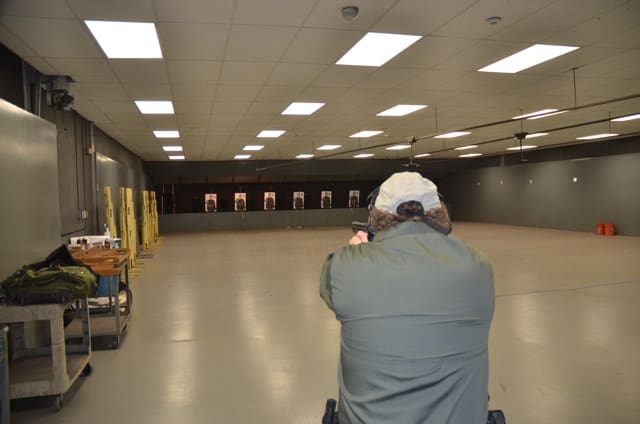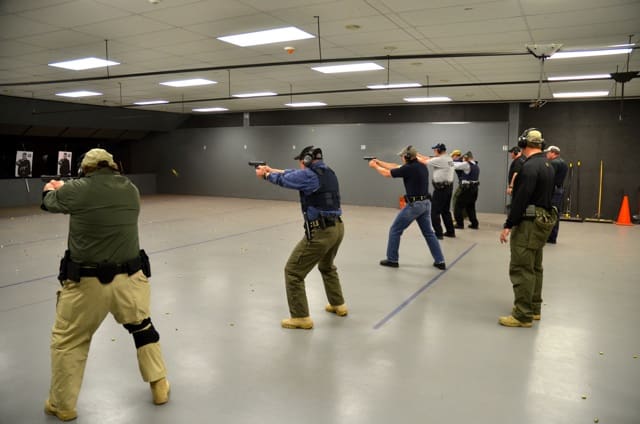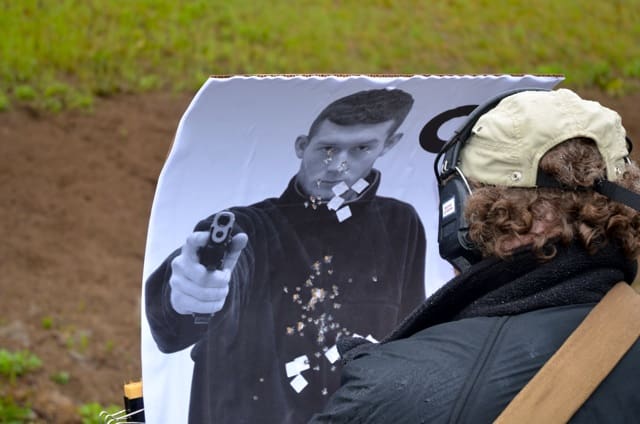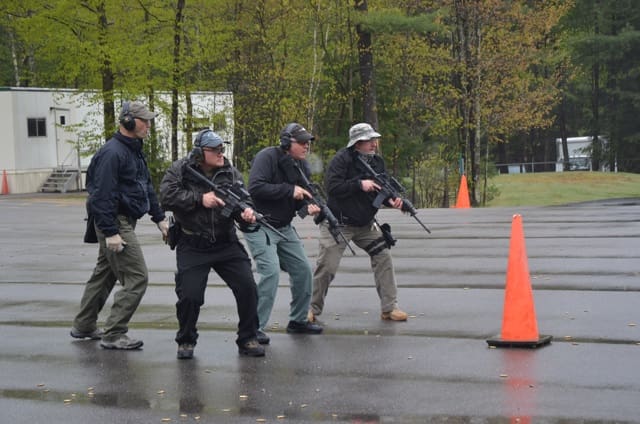RF and I recently attended the SIG SAUER Active Shooter Response Instructor Class. As a law enforcement officer in The Land of Enchantment (New Mexico) I wanted to see how SIG approached active shooter scenarios. I learned a great deal about active shooter response teamwork and tactics. As usually happens at any top-rank firearms instruction class, the course also reinforced an important lesson. Once again I learned the truth of the philosophy espoused by that great American philosopher Clint Eastwood: a man has to know his limitations. SIG SAUER made the point on day one using paper targets . . .
Class members started by shooting their pistol at targets from a static position from the three, seven, 10, 15, 25 and 35 yard lines. We repeated the drill taking a single-step forwards, sideways and backwards. We also did shooting-while-walking drills, forward and backwards, from each line marker to the next.
We fired chest and head shots, concentrating on keeping the rounds between the eyes and nostrils (where rounds could penetrate unencumbered by the cranial vault protecting the upper head). The instructor varied the maximum time on target, testing the shooter’s ability to aim efficiently on a smaller and smaller target.
The walking drills required extreme softening of the steps. Shooters had to time the motion of the firearm’s sights in relation to their trigger pull. Head shots on the move proved to be impossible in all but the closest distances.
I tell my students that shots that fail to hit the target zone are not a “miss.” They’re a dead bystander. SIG emphasized the point by replacing generic blank targets with photographic targets depicting an active shooter surrounded by school children.
[HTML1]
After finishing the handgun drills, SIG students repeated the process with rifles. In his previous post, RF remarked how the comparison highlighted the obvious accuracy advantages of a long gun vs. a pistol.
[HTML2]
While using a rifle improved results dramatically during the shooting-while-walking drills, accuracy and the speed of shooting were still a major issue. The last rifle drill—where we ran towards the target and stopped dead in our tracks to shoot—suggested the optimal solution.
The bottom line: anyone who wants to use a firearm for self-defense needs to know what they can and cannot do with their gun. They must have a working knowledge of those limits and how those limits define their options. Or else.








To Quote
“The bottom line: anyone who wants to use a firearm for self-defense needs to know what they can and cannot do with their gun. ”
May I suggest the larger point for many readers.
“The bottom line: anyone who wants to use a firearm for self-defense needs to know what can and cannot realistically be done with a gun. “
I had a different thought about the closing remarks-I don’t think the two grannies featured in previous DGU o’ the day gave it much thought before the moment of truth. Although I could be wrong about the Filipina who had previously shot her two-timing man.
Same thing goes for the antis. Some people really just go by what they see in movies. I wouldn’t be surprised if 10-20% of the country thought you can actually bend bullets.
Shooting well is difficult.
This.
A few months back I checked the source article on that California Police DGU (the one where a guy turned and walked towards them with a pipe bender). At least half the comments said either one bullet should have been enough or that the officer should have shot the guy in the extremities.
It was disgusting to say the least.
A law enforcement officer from New Mexico – eh?
Do you have any insight into why New Mexico has gotten rid of its CCW reciprocity for about 5 or 6 states?
This article was obviously not written for this inquiry, but just thought I would ask.
As a matter of law, NM can only recognize out-of-state licenses if the other state’s requirements are the same or more stringent than NM’s. NM announced that they were not yet withdrawing recognition of the out of state licenses, but the state is performing an audit of all the other states’ licensing statutes to determine if NM is in compliance with its own law.
Some of the important markers include: classroom instruction and testing, passing a shooting practical, fingerprints and background checking. If the other states don’t have those and other requirements, NM cannot recognize their permits.
Time will tell what will change after the audit is completed.
One of the more nit-noy NM requirements is that the permits must be issued by the state, not by counties or municipalities. How does this make a difference? It doesn’t, but the NM law and the “audit” is not about encouraging reciprocity or enabling concealed carry and DGU, it’s about inhibiting them.
One big force pushing for training requirements nationwide is the NRA — which conveniently certifies instructors. Cha-chinggg. In my state the NRA lobbyist and the Brady/MAIG lobbyist have interchangeable positions. They both are trying to get restrictions passed.
Very telling exercises. Those should all be at least a few times a year as a reality check. I thought I was pretty proficient until I took a class alongside trained professionals, some of whom had been on recent operations overseas.
Are you actually shooting in that room with the drop ceiling?
Disregard the question. Having looked at the picture more carefully I have answered my own (stupid in hindsight) question. That looks like a very informative and valuable course. I wish I was closer geographically to take advantage of it.
RF remarked how the comparison highlighted the obvious accuracy advantages of a long gun vs. a pistol.
No surprise. The reason the M1 Carbine existed was that most people could not hit the broadside of a barn with a 1911. Nothing really wrong with the 1911, the troops were just incompetent.
Actually, I think most people would be more effective with a Ruger 10-22 than using a lot of pistols.
Comments are closed.